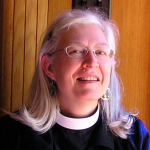I AM The Way
This first part of this gospel reading, the first four sentences, is one that I choose often for funerals. In the prayer book, there are several suggestions for funerals, and this is probably my favorite. The next part of the reading used to just drive me crazy, because it has been and is still used to build the case for an exclusivist version of Christianity. Now I think the folks who do that are totally misguided, but I am in the minority, and I’ll get to that in a bit.
So! Jesus said, Do not let your hearts be troubled. Believe in God, believe also in me. In my Father’s house there are many dwelling places. If it were not so, would I have told you that I go to prepare a place for you? And if I go and prepare a place for you, I will come again and will take you to myself, so that where I am, there you may be also.
This is typical bridegroom talk, or at least the man who is speaking on behalf of the bridegroom. In my Father’s house there are many dwelling places. The original dwelling in the Middle East, and it is still seen today, is a tent. It is not a small thing that one can backpack with. Rather, it is quite heavy, and very large. The women make the tents out of goat hair on looms, and working together they put them up. The man’s tent was large, with two rooms, a front room and a back room. The front room was the men’s room, where food was served to associates, business was conducted, this was the public space. The back room was the women’s area, and for children, and was not public at all. This is also a polygamous society, where it was expected that a man that was well to do would have more than one wife. Each wife had her own small tent, where she entertained her husband when he came, and where she raised her children.
When people started living in towns, there was some adjustment needed. But there is still a front/public space, and then the back/private space. And, when a new family was made, that is, when one of the sons brought home a wife, a new room was added to the house somehow. If you look at the pictures of these houses, it looks very haphazard to our eyes.
When I use this passage for a funeral sermon, I frequently use it as a way to say that there are many different relationships we can have with God. Some of them are ones we recognize as Christian, and some are not. And that’s the point. God’s house is huge, and we are all family, but those rooms are going to look different from each other, they are not all the same, and we don’t all have the same relationship with God. I think this is good news. God invites us in, and says, here is your room, it’s all ready for you. God does not say, do you believe this or that? No!
That picture of Peter at the pearly gates is a way of talking about our actions, not our beliefs. And if we are going to keep going in that direction, I would suggest that we use the work of C.S. Lewis, who would say that everyone, yes everyone, is allowed in, in fact, is invited, not just allowed – much to some people’s disgust – but that we really seriously cannot bring anything with us. That’s a problem for some of us.
So then we come to the second part of this reading: You know the way to the place where I am going.” Thomas said to him, “Lord, we do not know where you are going. How can we know the way?” Jesus said to him, “I am the way, and the truth, and the life. No one comes to the Father except through me. This passage has been used as justification for an exclusivist version of Christianity, a version that hits people over the head, saying essentially, it’s my way or the highway. Since it is used so often, I think it is very important that we all understand what is being said here, and what is not. Please ask questions! I want to start with the important observation that we are dealing with a major translation issue here. It is not easy to translate from English into Japanese, because they are not cognate languages. That is, they do not come from the same roots. Translating from Latin into English, or from German into English, is much easier, because English comes from both of these languages. There are still issues, but not like translating between Japanese and English! Jesus spoke Aramaic, which is closely related to Hebrew. They are also not cognate languages with English, which means we can expect major translation issues. There is also the issue of “how” the language works. I really didn’t understand Hebrew until I took ASL. In ASL, you learn to “draw” pictures to explain things. It is a very different conceptual process than speaking English. In Hebrew, you also draw pictures to explain things. You draw pictures with speech, but it is miles away from Greek, which is related to English.
Why is all of this business about language so important? Because how we understand these words and phrases is critical to how we use them. What I want to propose is that we look back and remember that the early followers of Jesus were known as followers of The Way – not followers of Jesus! Jesus was what we now might call a guru, with disciples, who went to him to learn how to live a Godly life. He taught them The Way. If we look at this passage again with this in mind, it starts to change the meaning. Thomas says, we do not know where you are going, but what we do know is that you are talking about going away. If you leave us, how will we know The Way? In other words, who will be our teacher? Then Jesus responds, and here is where the language is so important, the way I am is the way, is one way to understand this. There is one other thing to add to this. Remember God’s answer when Moses asks God for God’s name at the burning bush? God’s response was “I am,” only in Hebrew it comes out more like “I am being who I am being” or “I will be who I will be.” Now we have Jesus with a bunch of “I am” statements, I am the bread of life, and so forth. If we substitute “God” for “I” then we have “God is the bread of life” that works, and “God is the way, the truth, and the life” that works. What does not work is “Christianity is the way.” Jesus does not say that at all. What he is saying here is that if you want to be aligned with God, then follow my way – and there is no difference between what and how I “am” and what I teach. Therefore, the way I am is the way you are to be to follow the way.
So how does that work itself out for us here and now? First I want to read you a meditation by Bishop Steve Charleston: “There is plenty of room at this table, please pull up a chair and join us, everyone is welcome. There are no strangers in the house of God, only family, only friends, only people like you and me, who believe or doubt, laugh or cry, are found or lost, people who have walked in through any door, through any story, to find themselves in this place, amazed that love invites the unloved, that faith comes in all shapes and sizes, that hope is deeper than dogma. Come rest here. Be at peace. Listen to the sound of countless voices, speaking a thousand languages. This is your home because it has no walls, your shelter because it stands wide open.”
This is no narrow vision of a church with doors shut and requirements about who is welcome and who is not! Everyone is welcome. One of the things Jesus taught was to widen the circle. You probably know the quote from the poem Outwitted by Edwin Markham: “He drew a circle that shut me out-Heretic , rebel, a thing to flout. But love and I had the wit to win: We drew a circle and took him In! We see Jesus doing this over and over again. He went to the outcasts, the underlings, the nobodies. He told parables that had them win, or that opened the circle. One of his parables had the servants out combing the countryside for the poor and outcasts, bringing them in to the feast. The description of these people makes it clear that these are people who are not welcome in the temple – and Jesus says, they may not be welcome in the temple in Jerusalem, but they are welcome in God’s house.
It is clear that if we are going to follow the way of Jesus, we need to open the doors wider, we need to draw the circle bigger and then bigger again. This is not always comfortable. One of the things that strikes me about what Bishop Steven gives us in his vision of the reign of God is this business of having a home that has no walls and a shelter that stands wide open – this feels unsafe to those of us who have grown up with solid walls and doors with locks on them. I think about a lanai, that Hawaiian structure that has posts and a roof, but no real walls, and I just saw the picture of an amazing place called chapel in the woods in Arkansas. It wrinkles our brains, doesn’t it? But that’s kind of the point, that’s what Jesus does. If we didn’t have walls, we couldn’t keep anyone out. We would not want to have things that could be stolen, it would totally change the way we would do things!
There is a group in the diocese that is doing something like that, it’s called Open Cathedral. They go out with a card table, some bread, some wine, and lots of sandwiches, and they offer eucharist to anyone and everyone that wants it, no questions asked, and then they pass out the sandwiches. It sounds a lot like Jesus telling the disciples to feed the people with some bread and fish, doesn’t it?
So what about us? I’m not offering any real answers here, mostly questions. But the bottom line of those questions is this:
How do we translate the Way of Jesus for ourselves?
Where is it that our walls get in the way of Jesus getting to us?
Where is it that our walls get in the way of our following Jesus?
Is it time to take down some of those walls? What would have to change?
What does it look like for us, personally and as a group to follow the Way?
What are we doing, and not doing yet that we want to do?
Another way of asking that is to say, OK, if Jesus showed up tomorrow, what would we be pleased to have him see, and what would we just as soon he not see?
And would we be happy if Jesus said: There’s a big party I’m throwing down in the Tenderloin, please come! Oh, and bring some bread and wine with you, OK? And a few sandwiches if you can…


